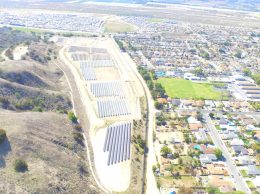Much has been said about the potential of the green economy to create the well-paying jobs of the future.
Whether it’s alternative energy, technology directed at higher energy efficiency or simply better ways of stewarding the planet while making a profit, we are told time and again that such is the way of the future.
We believe it. To our thinking, the only questions that remain about the threat of anthropogenic climate change are how best to address it in a way that balances preservation with prosperity and how soon we can start.
But a string of blows to alternative energy in the Tri-Counties demonstrate the perils of the future green economy.
The most salient example is Clipper Windpower. The company rocketed to prominence and booked revenue of more than $730 million and employed 770 at its peak. About 200 of those jobs were high-quality positions at the firm’s headquarters in Carpinteria. Warranty problems left the company tight on cash, and the global downturn made it hard for wind farm developers to secure the financing for new revenue. A capital infusion from United Technologies Corp. couldn’t keep Clipper alive. It now appears that the company’s new private equity owners will lay off the entire tri-county workforce.
This is not the first blow. In recent years, Solarworld, a German firm, purchased a solar panel factory in Camarillo and shuttered production there, electing to move it to Oregon while keeping a sales and marketing staff in Camarillo.
And REC Solar, a San Luis Obispo success story that in the course of 15 years has become a major player in the solar installation business, has undergone a major management shakeup.
When Camarillo-based solar inverter supplier Power-One decided to invest in a new U.S. factory, it picked Arizona rather than its home base.
Looming in each of these stories is government policy. Even with serious problems, Clipper might have survived if congressional leaders dispersed the pall of uncertainty hanging over the passage of the federal production tax credit. As for Solarworld, the Obama administration has poured billions of dollars into solar energy, but the trade sanctions it secured against over-subsidized Chinese panels appears toothless.
And then there are the usual California regulatory woes. Oregon is an easier place for Solarworld to expand production than California. And in the case of Power-One, asking a corporation whether it would prefer to build a factory in Arizona or California is like asking whether you’d prefer a back massage or a root canal.
The growth of alternative energy, then, varies with government policy, which itself is as fickle as our nation’s politics. Even the region’s successes, like San Luis Obispo County’s massive solar installations, have been driven by government goals. Also looming in each alternative energy story is the price of fossil fuels. It’s come down, making even subsidized alternative energy less competitive. You might say Clipper got fracked.
Yet the price of fossil fuels also results from government policy. In the long run, government can’t subsidize alternative energy into viability.
The best our policymakers can do, for the planet and for our economy, is to remove existing subsidies for fossil fuels — both the explicit subsidies in the tax code, and the subsides implied in continuing to let many industries externalize the negative impacts of their business onto foreign populations and future generations. California’s landmark first auction of greenhouse gas credits was a market-based step in the right direction.






 Print
Print Email
Email


















Great article. I wanted to point, however, that even though our region has had some unfortunate events strike down our renewable energy companies the larger trends are quite positive. Prices for solar power, in particular, have plummeted – in large part b/c of the massive influx of Chinese solar panels into markets around the world. Solar is well on its way to becoming a competitive source of power without subsidies in just a few years. Wind power prices have also fallen substantially, again driven in large part by Chinese companies. The flip side is the demand story: countries like Germany, Spain, Italy, and again China are driving strong demand for renewables. The US is catching up and solar power installations have grown almost 100% two years in a row. Wind power is growing at rates of 25% or so over the last few years. Combined, these two sources of power alone will, if current rates continue at even half of their torrid recent rates of growth, to about half of our power coming from renewables by 2030 or even sooner. And energy efficiency and conservation will at the same time make a big dent in demand. So the future is bright in some ways. The big unknowns are whether we can transition away from fossil fuels in time to avert major climate change and/or resource shortages (peak oil). Time will tell.